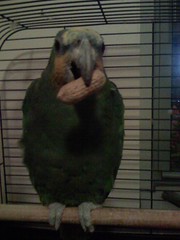 I’m taking care of my friend Dan’s parrot. His name is Chicken because he clucks like a chicken. He has beautiful green feathers and a yellow crest. He sits in his cage and looks very intently at me, maybe trying to figure out what could possibly be so interesting about a piece of metal that I’m staring at all day. Parrots are intriguing creatures, highly intelligent, they use their beak as if it were a third claw, gripping the side of the cage to navigate around.
I’m taking care of my friend Dan’s parrot. His name is Chicken because he clucks like a chicken. He has beautiful green feathers and a yellow crest. He sits in his cage and looks very intently at me, maybe trying to figure out what could possibly be so interesting about a piece of metal that I’m staring at all day. Parrots are intriguing creatures, highly intelligent, they use their beak as if it were a third claw, gripping the side of the cage to navigate around.
Today I opened the door to his cage to see if he wanted to come out to explore the apartment. I tried to coax him out with a cashew, one of his favorite snacks. Strangely enough, he remained in the cage, even when I went out for the evening, he did not venture from his perch.
I wonder if this is a common trait of all living creatures, including us humans. Even when the door is opened to us, inviting us to come and explore another world, that is both exciting but also scary, we choose to remain in the cage where we are comfortable and safe. Sometimes we don’t even realize that we are in a cage, because we have grown so accustomed to “the way things are”. We don’t dare venture outside this cage because it requires a leap of faith, and quite frankly, we are too chicken to make that jump.
Tonight I took a step back to evaluate what my personal and professional goals are, and came to the conclusion that I don’t want to be consulting for the rest of my life. It’s been coming more and more apparent over the last year or so, but recently (maybe due to the inspiring people I met at Podcamp Boston) I’ve come to realize that I dislike having to sell new project work all the time. There is something very gratifying about doing a client project well, and pleasing your customer, but I don’t think it compares to passionately doing your own thing. So what if it fails – at least you have tried. And the worst case is that I have to go back to consulting – I know I can make a living at it.
From Jay Dedman, one of the creators of FireAnt, a videoblog aggregator tool:
So I guess I become one of many software entrepreneurs who pass on this advice: Do it for as long as you can on your own. Success is definitely about good ideas, team, and execution…but it’s also all about contacts and luck. Don’t believe the hype of quick riches. haha and trust yourself.
Momentshowing
I’m thinking about these things right now as I contemplate my next move. It’s a common theme that has been echoed in the Founders At Work book and other people I’ve spoken to at conferences, SXSW and other tech events. Do it by yourself as long as you can, and it will be obvious when you need to go for funding. Read Jessica Livingston’s interview with Joel Spolsky, founder of FogBugz. Joel says:
Remember, the original model was, “How can we become a big consulting company and then build a software company inside a consulting company?” The consulting company was a means to an end. It was to get cash flow, so that you could build a real software company. And when you were done, the theory was you’d still have these consultants, but software companies often need consulting arms.
37Signals has also succeeded in going from a consulting company to a products company, and report that it was a gradual process, one day at a time. They didn’t just cut off all of their consulting customers from one day to the next.
Basecamp was developed alongside client work and was treated as essentially a third client. It had to compete for resources on equal footing with other clients, which meant that every hour we spent on it had to really count. With constrained resources, you realize the value of the marginal hour very quickly. You can’t just goof around with science projects, open-ended explorations, and play time with new whiz-bang technology. Instead, you have to deliver real value, real soon. Otherwise the project is simply going to languish as it loses out to the “real work” of paying clients.
Ask 37signals: How to go from clients to products? – (37signals)
Digesting these words is encouraging as I make the decision to not take on any additional client work, but to maintain on our existing clients, and focus on building the products and services that I want to offer. More on that later. Thanks to these webpreneurs for sharing their insight, and thanks to Chicken for being a mirror of the chicken that is me sometimes.


 How did I miss the
How did I miss the 
 RSS - Posts
RSS - Posts

























Recent Comments